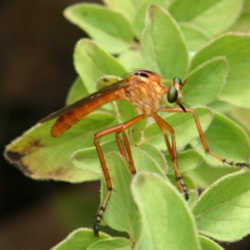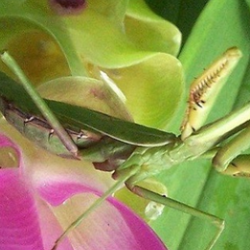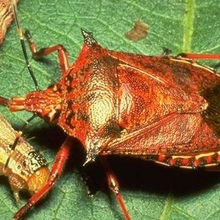
(Editor's Note: This article was originally published on April 14, 2008.)
Most of them look like the creatures from bad ‘50's horror flicks. People recoil instinctively when encountering them. Gardeners run for the bug spray, or a weapon, and ask questions later. Like the spider, who gladly consumes whatever tumbles into its web, the majority of these predators will make a meal on most of the insects that they can catch. Others are pest specific, and will predominantly hunt insects of a certain type.
One of the most familiar garden predators is the Praying Mantis. The Order which Mantids are found is Dictyoptera, the Family is Mantidae. Its long, stick-like body and front legs held in the recognizable "praying" position make it easily identifiable. The green and brown coloring make it blend right in with the foliage in the garden. It sits near high traffic insect areas and waits. A Praying Mantis can sit so still for a great length of time that its easy to overlook one. This is exactly what the Mantid is counting on. When an unlucky insect lands a little too close, the Mantid will simply leap on it, grabbing it in those powerful front legs, and the helpless bug rarely escapes. Praying Mantids are found throughout the world, from the rainforests of the equator, to arctic tundra. Generally speaking, there are far more living in the warmer climates than the colder ones, but the Praying Mantis is adaptable, and manages to survive world-wide.
The Praying Mantis has excellent eyesight, and is capable of turning it's head without moving its body, much as a warm-blooded mammal will do. This only adds to the "creepiness factor" and helps put it at the top of the list for the villain in bad Sci-fi flicks. The Praying Mantis is not poisonous, and quite docile to handle. Some cultures even keep them as pets.
The diet of the Praying Mantis consists of files, moths, caterpillars and crawling insects. Large Praying Mantids have also been known to capture the occasional hummingbird, but this is extremely rare. Generally, they are predators of many of the more undesirable residents in one's garden, and tend to help us rid our plantings of juice sucking plant bugs such as Japanese Beetles. The egg cases of Praying Mantids are available for purchase through many garden supply sources, and a great number of gardeners will overlook the occasional butterfly one may catch, for the overall good that the ultimately do.

 The Wheel Bug, Arilus cristatus, is another insect with a high "creepiness factor." It looks like something from the Jurassic Era that suddenly woke up and decided to take residence in the modern garden. The large "wheel" on it's back makes it quite identifiable, and the spines certainly give it a formidable look. If the prehistoric appearance isn't enough for a reason to shy away, the odor it produces when distressed will probably convince any remaining skeptics. It is of the Order Hemiptera, or True Bugs, and the Family Reduviidae.
The Wheel Bug, Arilus cristatus, is another insect with a high "creepiness factor." It looks like something from the Jurassic Era that suddenly woke up and decided to take residence in the modern garden. The large "wheel" on it's back makes it quite identifiable, and the spines certainly give it a formidable look. If the prehistoric appearance isn't enough for a reason to shy away, the odor it produces when distressed will probably convince any remaining skeptics. It is of the Order Hemiptera, or True Bugs, and the Family Reduviidae.
Sometimes confused with its cousin the Leaf-footed Bug, the Wheel Bug is different because it uses its sucking mouthparts to drain the juices from another insect instead of plants. They will eat flies, aphids, caterpillars, and yes, stink bugs. Wheel Bugs are not aggressive, and move slowly, but those "fangs" that it sports are capable of a nasty bite. The result is extremely painful, and can remain so for several weeks. It's best to leave them be, and let them go about their business. While they can fly, they do so awkwardly, so most often one will see them stalking quietly among the plants.
 Dragonflies are a beneficial garden predator. They are of the Order Odonata, and they are often called Mosquito Hawks, because of their fondness for those insects. A good population of dragonflies can consume as many mosquitoes as a colony of Purple Martins. They generally favor areas that have standing water, or are somewhat damp, because of their favorite food, but will venture into flower gardens on occasion also.
Dragonflies are a beneficial garden predator. They are of the Order Odonata, and they are often called Mosquito Hawks, because of their fondness for those insects. A good population of dragonflies can consume as many mosquitoes as a colony of Purple Martins. They generally favor areas that have standing water, or are somewhat damp, because of their favorite food, but will venture into flower gardens on occasion also.
There are many different species of Dragonflies, too many to list in this small article. They can range in size from tiny little guys with thread-like bodies, to huge insects with a wingspan of several inches. They are quite colorful, and many sparkle with iridescent day-glo hues that are quite jewel-like. They are found world-wide wherever a supply of fresh water is available.
Dragonflies are capable of flying in a manner that is more like a hummingbird than an insect. They fly forward, backward, and can hover in one spot with ease. Capable of instant acceleration, they dart and swoop through the garden like tiny fighter jets. The catch their prey on the wing, and while they prefer mosquitoes, they will stalk other insects as well. Butterfly gardeners might be dismayed if a large dragonfly takes up residence among their flower beds, but this is simply a natural action for the hunter. The loss of a few butterflies is sad to think about, but a Dragonfly does so much good by eliminating pest insects, it's best to let them stay.
 Robber Flies are another insect with similar hunting habits as the Dragonfly. Of the Order Diptera, and the Family Asilidae, they are tough and quick little guys that hide among the garden plants waiting for unfortunate victims. They can catch their prey in flight, or wait nearby for the right moment to make a short zip to the unwary insect. They are similar to the Praying Mantis in that they can turn their head and look about the area searching for a suitable meal.
Robber Flies are another insect with similar hunting habits as the Dragonfly. Of the Order Diptera, and the Family Asilidae, they are tough and quick little guys that hide among the garden plants waiting for unfortunate victims. They can catch their prey in flight, or wait nearby for the right moment to make a short zip to the unwary insect. They are similar to the Praying Mantis in that they can turn their head and look about the area searching for a suitable meal.
Generally a shy insect, they go about their business un-noticed most of the time. Their favorite habitats are sunny areas with generous plant life. With their stealthy actions and quick departure from the scene, the name Robber Fly fits well. They are found throughout the world, and have adapted to many different climates. Also known as a Hanging Thief or Bee Killer, Robber Flies will tackle bees, spiders, grasshoppers, butterflies and wasps much larger than themselves. The species Dogmites generally eats its prey while hanging from one leg, thus the name Hanging Thief.
Many predator insects inhabit gardens world-wide. It's just a natural fact that should be accepted, and encouraged. They bring balance and order into the chain of life, and without them, insect populations would soon become out of control. A healthy garden should also have a healthy population of predator insects. It's difficult to see a pretty butterfly or a honeybee being used as a meal, but the predator does so much good, that the occasional sacrifice of a desirable insect must be expected. A garden with several species of predators is a well functioning unit that sustains itself, so that little intervention by the gardener is needed. Please be aware of your ninja visitors, and welcome them to your flowers. They are serving a necessary purpose.

















